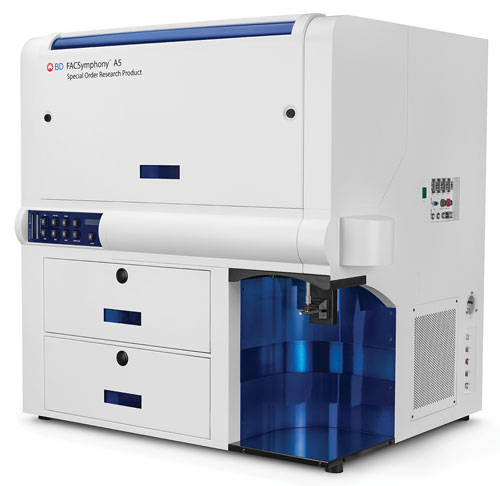November 15, 2016 (Vol. 36, No. 20)
Like A Determined Athlete, Flow Cytometry Is Training for More Demanding Routines
Flow cytometry retains the ability to analyze thousands of particles per second. What’s more, flow cytometry shows no signs of tiring even as it trains for yet greater feats of speed, power, flexibility, and coordination. For years, flow cytometry has demonstrated prowess in a sort of biophysical triathalon—a combination of fluidics, optics, and electronics. Of late, however, flow cytometry seems to be taking the “no pain, no gain” philosophy to new extremes as it prepares for increasingly grueling contests. As our panel of experts make clear, flow cytometry is looking to work additional biophysical activities into its routines. For example, flow cytometry is enhancing its multiparameter, single-cell, and data-processing capabilities, while strengthening its high-throughput characteristics. Also, flow cytometers are feeding individual cells into systems that perform quantitative PCR and next-generation sequencing.
GEN: Cell viability assays and flow cytometry seemingly go hand in hand. Are there any new uses for flow cytometry in the drug discovery process?
Dr. Bobat Multiparametric analysis in flow cytometry has become particularly useful, and some instruments can be configured to detect up to 20 parameters simultaneously. Since phenotyping cells plays a major role in multiple research areas, this process is useful, allowing researchers to distinguish individual cell subsets in a multiplex format.
Other emerging uses of flow cytometry are in toxicology biomarker quantification. Multiplexed assays for both microRNAs and proteins can be performed using the Firefly® platform to measure up to 68 markers directly from exceedingly small volumes of crude biofluid, including those for toxicity, from animal models, human subjects, and cell cultures.
Dr. Holden Flow cytometry is an efficient and rapid means of simultaneously assessing cell viability, immunophenotype, and function. Screening for target cell response via up- and downregulation of surface markers and cytokines while also assessing proliferation provides deep insights into a molecule’s potential pharmacologic activity.
Flow cytometry plays an important role in the characterization of chimeric antigen receptor (CAR) T cells and other cell types used in cell therapies, and biologics manufacturing can be monitored with flow cytometry.
Ms. Ellis-Ovadia Flow cytometry has always played an important role in the drug discovery process, and new products emerging with high-parameter, high-throughput designs will ensure it will play a larger role over time. For example, at the Congress of the International Society for Advancement of Cytometry (CYTO), Bio-Rad previewed the ZE5 Cell Analyzer, which is still in beta testing but can analyze up to 27 parameters simultaneously and process 96- or 384-well plates in less than seven minutes, making it ideal for the drug discovery process.

Dr. L’Huillier The past decade has seen a shift in drug discovery away from small molecules and toward biologics. This change has also necessitated the need for detecting changes in the immune system to ensure drug safety and efficacy, both in preclinical and clinical studies.
Antibodies and recombinant proteins need to be assessed for immunogenicity, immunosuppression, and potential induction of deadly cytokine storms. As biologics are then scaled up, flow cytometry and fluorescent protein aggregation dyes, such as Enzo’s ProteoStat® dyes, become key tools for process development to ensure a robust, highly productive cell line for drug production.
Mr. Zock We continue to see uptake of high-throughput flow in drug discovery for antibody discovery, immuno-oncology targets, and adoptive cell therapy where speed, miniaturization, content, usability, and insight make the difference. Scientists are using our iQue® Screener platform to perform multiparameter, cell-mediated cytotoxicity assays that assess the cancer-killing potential of engineered CAR T cell preparations or purified tumor infiltrating lymphocytes.
It is possible to combine measurements of cytotoxicity and apoptosis with immuno-phenotyping and cytokine profiling with capture beads in the same assay. When such combinations are used, a very comprehensive picture of both target and effector cell health can be acquired in a short timeframe.
Mr. Yousaf New applications for imaging flow cytometry are being discovered at a rapid pace in the area of drug discovery. A recent report assessing natural killer cell biological function by measuring polarization and secretion of lytic granules is providing insight into the treatment and prevention of immune deficiency and malignancy.
Some researchers have reported results of delivering photosensitive drugs via carbon nanotubes to ovarian cancer cells. They were able to distinguish distinct cell responses to different drugs. At the National University of Singapore, researchers from the laboratory of K.S. Tan have used imaging flow cytometry for screening compounds that disrupt the Plasmodium falciparum digestive vacuole and thus show promise in curbing the spread of malaria. In a recent report, the researchers assert that their approach demonstrates robustness and high-throughput capability.
Mr. Colville Viability is still a key application for flow cytometry. Many users are taking this a step further. They are using different fluorescent probes as well as antibodies targeted to cell cycle proteins and phosphorylated signaling proteins to simultaneously look at proliferation and cell health. Combined, these methods, along with surface marker antibody staining, give the unprecedented ability to look at the status of cellular subsets.

GEN: With single-cell genomics rapidly becoming a go-to analysis technique for many cancer researchers, how have flow cytometry methods changed to keep pace with next-generation sequencing technology?
Dr. Bobat Single-cell mass cytometry, or cytometry by time of flight (CyTOF), is a new technology that combines flow cytometry with time-of-flight mass spectrometry (TOFMS) to generate a readout at the single-cell level. Relevant markers are labeled with one of over a hundred different types of metal-tagged antibodies (or “mass tags”) and detected via mass spectrometry.
CyTOF dramatically reduces problems associated with background noise and spectral spill-over. This technology has already been used to phenotype cells and profile cytokines. As a result, we are seeing an upward trend in the number of published articles using this technology.
Dr. Holden Although next-generation sequencing and other molecular biology techniques can yield important information about single cells, that information is inherently limited to the genome. Flow cytometry’s ability to assess immunophenotypic and functional information is crucial to understanding the larger picture. The techniques are complementary, with neither standing alone.
Ms. Ellis-Ovadia Small sample sizes! Bio-Rad is very focused on providing single-cell analysis solutions that fit well into the next-generation sequencing workflow, and that means the ability analyze very small sample sizes. It also means practical design that allows users to return unused sample to a well and to retain the sample for analysis with ancillary methods such as next-generation sequencing and single-cell analysis.
Dr. L’Huillier Cell sorting has led to a number of exciting technologies such as single-cell RT-PCR. These technologies have allowed unprecedented improvements in data collection. With current advances, the field is going yet further.
For example, similar sorting techniques are being used with next-generation sequencing to obtain extremely detailed gene expression profiles and single-nucleotide polymorphism (SNP) analyses. In addition, advances with in situ detection of nucleic acids using flow, such as Enzo’s FlowScript® platform, are allowing gene expression, SNPs, and translocations to be directly detected without the need for sorting, greatly increasing experimental throughput.
Mr. Zock Keeping up the pace means evolving traditional flow cytometry from a tube-centric methodology to a plate-centric one. Every aspect of the workflow, from sampling to data analysis and visualization has been enhanced in the iQue Screener platform, which combines automated microvolume sampling (which can process microplates in minutes) with plate-level analytics (which surpasses that available in traditional flow software).
The platform can transform flow into true suspension cell and bead screening. Whether you are trying to get more out of the precious few cells you have or screening large numbers of samples against immuno-oncology targets, getting actionable results fast is now possible!
Mr. Yousaf Genomic studies can rapidly focus in on genes of interest in cancer biology. Many of the gene products have biochemical functions inside of the cells, which are being investigated using imaging flow cytometry.
For example, in a recent study on the inherited muscle disorder rhabdomyolysis, researchers sequenced genes from individuals within an affected family and identified mutations in a gene that encodes a protein known to have an effect on Golgi-endoplasmic reticulum fusion in cell lines. Cells from individuals in the family study were then assessed for their Golgi-endoplasmic reticulum fusion by imaging flow cytometry and found to differ in those with the mutations.
GEN: Imaging flow cytometry, multiparameter flow cytometry, and quantitative flow cytometry are all techniques that seem to be peaking in terms of their use. What does the future hold for the field?
Dr. Bobat High-throughput options will be increasingly necessary in clinical settings where time and sample volumes are at a premium. We are already seeing automated sample-loading technologies that use multiwell plate-based sampling systems.
Reagents will also need to keep up. Researchers will need antibodies compatible with CyTOF instruments, for example. This means developing antibodies that are presented in a carrier-free format so that they can be reacted with the heavy-metal isotopes used in mass cytometry.
Dr. Holden Flow cytometry now has standard-of-care status in the diagnosis and monitoring of most hematolymphoid malignancies, and routine tests, such as lymphocyte subset analysis, are frequently automated. The field, however, is hardly static. For example, it is incorporating ongoing improvements to workflow that simultaneously improve efficiency and reduce opportunity for error.
Basic research is similarly realizing the benefits of improved instrumentation, with consequent application of the technique to smaller and smaller particles, such as exosomes, as well as to the microbiome. Adjacent markets such as food and beverage as well as oil and gas have yet to exploit fully the potential applications of flow cytometry.
Ms. Ellis-Ovadia Interest in flow cytometry is growing, but recent flow technology has not evolved much beyond 10 parameters to meet that need. Multiparameter capabilities also need to begin including design elements that provide ease of use and flexibility in order to see applications continue to expand beyond the core facility and into individual laboratories.
Dr. L’Huillier The most exciting trends in flow cytometry involve the convergence of cytometry with other technologies. This began with imaging flow cytometry, and it has extended into mass spectrometry with the advent of mass cytometry. Mass cytometry enables the multiplexing of many parameters by complexing heavy metals to probes.
Another example of merging flow cytometry with other technologies is the use of flow cytometers to feed individual cells into systems that perform quantitative PCR and next-generation sequencing. Such advances hold amazing potential.
Mr. Zock I challenge the notion that these technologies are “peaking.” They continue to rise, as indicated by the proliferation of scientific papers, the success of company fund raising efforts, and the amount of medical “buzz” in the growing areas of immuno-oncology and adoptive cell therapy.
Understanding and harnessing the immune system to fight disease using high-content tools is escalating. The future of immuno-oncology is in combinatorial therapy, further increasing the need for high-capacity data generation and analysis tools from early development to bioprocess manufacturing and quality control.
Mr. Yousaf The applicability of imaging flow cytometry is just beginning rather than peaking. Peer-reviewed publications, now numbering well over 650, continue to accumulate as the technology becomes more widely available. For example, radiation biodosimetry assays that quantify radiation damage in cells have been automated using imaging flow cytometry. There has been an enormous increase in extracellular vesicles research, and imaging flow cytometry is being used to identify and characterize these particles.
Mr. Colville Multiparameter flow cytometry continues to be an important cellular analysis technique. Researchers are continuously pushing boundaries as they seek to increase the number of simultaneously measured parameters. By taking advantage of improved instrumentation that clogs less frequently and processes samples more quickly, researchers can study more complex sample types such as tumor digests.
Additionally, technologies such as PrimeFlow are allowing flow cytometry to take gene expression analysis to the single-cell level. PrimeFlow RNA assays can simultaneously detect messenger RNA transcripts and protein markers within the same cells, shedding light on otherwise hidden complex interactions.
FoxP3—Classic Treg Marker
While FoxP3 is a commonly used marker for regulatory T cells (Tregs), the identification, isolation, and characterization of Tregs all remain active areas of research. According to a BD Biosciences application note, the literature contains a growing list of targets. (These are approved for use only in the European Union.)
To support these emerging discoveries, BD has a portfolio of reagents and solutions. For example, previously localized primarily on B cells, dendritic cells, and certain subsets of T cells, CD39 has recently been shown to be coexpressed with FoxP3 in CD4+ Tregs in humans and mice. This discovery is adding to the growing list of cell surface markers such as CD25, CD45RA, HLA-DR, and CTLA-4, that are important in the identification and functional characterization of CD4+ Tregs.
Extracellular ATP and its metabolites are potent regulatory molecules modulating a broad range of cell and organ functions. Cellular ATP release is an indicator of tissue destruction and a danger “signal” that activates the immune response. CD39 hydrolyzes extracellular ATP (or other triphosphates) into its respective nucleotides such as AMP. Extracellular nucleoside monophosphates are, in turn, rapidly degraded to nucleosides (e.g., adenosine) by soluble or membrane bound ecto-5’-nucleotidases (CD73). Peri-cellular adenosine then mediates anti-inflammatory T cell responses. Coexpression of CD39 and CD73 is thought to be one of the key mechanisms of immunosuppression mediated by Tregs.
The B brand anti-human CD39 (clone TÜ66) monoclonal antibody is a novel marker for human Tregs and is available as PE and APC conjugates in ready-to-use reagent kits for flow cytometry. TÜ66 recognizes ENTPD1, an ectoenzyme that belongs to the family of ectonucleoside triphosphate diphosphohydrolases (ENTPDases). The members of this family are involved in extracellular nucleotide catabolism, controlling the extracellular nucleoside triphosphate pool.







